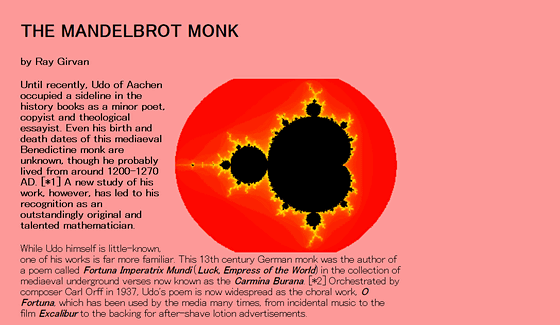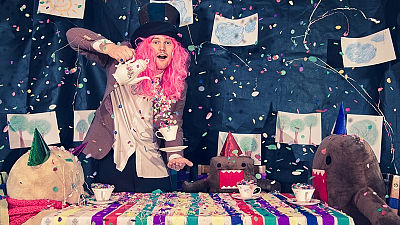A monk's mathematician who manually drew that "Mandelbrot gathering"

Drawing a fractal Mandelbrot set has a mysterious nature that details and the whole have self-similarity, and similar patterns repeatedly appear no matter how far it expands. There is a joked article that there was a priest who had manually calculated and drawn fractal figures of this Mandelbrot group in the 13 th century without computers.
THE MANDELBROT MONK
http://users.math.yale.edu/public_html/People/frame/Fractals/MandelSet/MandelMonk/MandelMonk.html

A monk, Udo of Aachen (Audhen, Udo), who is believed to have been living from 1200 to 1270, has various aspects such as mathematicians, poets, copies, photographers, and theologians of theology. Udo's own name is not so famous, but one of his works "Carmina Burana"Is known as a famous poetry collection. In 1937 the composerCarl OrffThe poem of Udo that is arranged by the word "O Fortuna" is widely spread to the present age as a choir song.
Mr. Bob Shipke, a mathematician at Harvard University, discovered Udo's unknown ability.Aachen CathedralMr. Shipke who came to visit discovered that a small pattern that looked like a Mandelbrot group was drawn in the books of the 13th century. Mr. Shipke said, "I was dumbfounded because this discovery was like discovering Bill Gates in the Dead Sea document, I felt it necessary to investigate more about Udo." .

As a result of examining the method in which this pattern was drawn from Mr. Shipque's materials left by Udo, Udo was an IBM researcher in 1976Benoit MandelbrotIt turned out that he studied "Mandelbrot group" as early as the 7th century. Also, Uod calls a 120 × 120 pixel plot drawn by the Mandelbrot collection method as "Colombian Arm", but even without using the latest "algorithm" at that time, 9 years to calculate without a computer It was said that it was necessary. The information was released on April 1, 1999, and it is a joke named after April Fools.

Related Posts:







